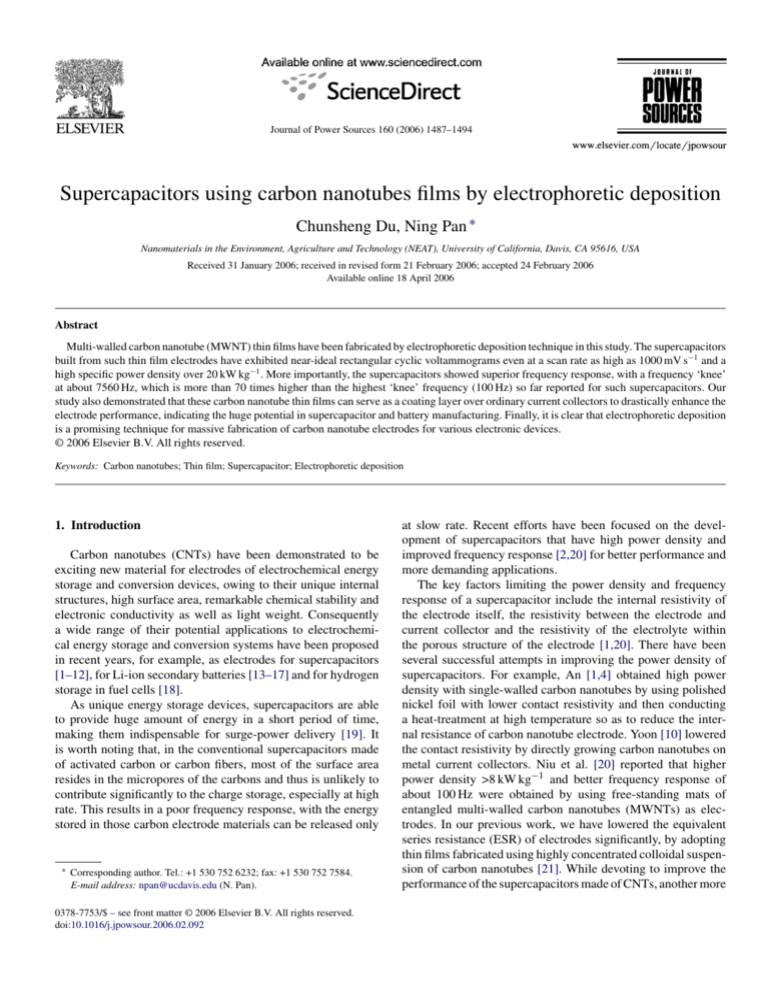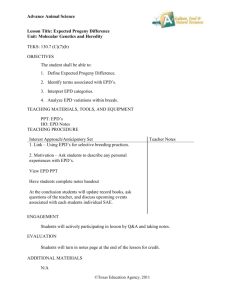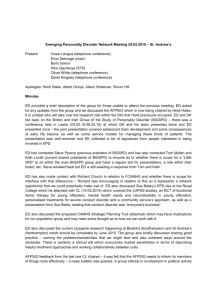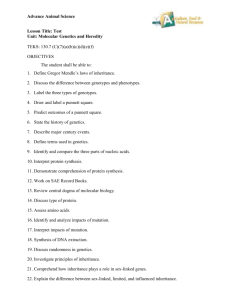
Journal of Power Sources 160 (2006) 1487–1494
Supercapacitors using carbon nanotubes films by electrophoretic deposition
Chunsheng Du, Ning Pan ∗
Nanomaterials in the Environment, Agriculture and Technology (NEAT), University of California, Davis, CA 95616, USA
Received 31 January 2006; received in revised form 21 February 2006; accepted 24 February 2006
Available online 18 April 2006
Abstract
Multi-walled carbon nanotube (MWNT) thin films have been fabricated by electrophoretic deposition technique in this study. The supercapacitors
built from such thin film electrodes have exhibited near-ideal rectangular cyclic voltammograms even at a scan rate as high as 1000 mV s−1 and a
high specific power density over 20 kW kg−1 . More importantly, the supercapacitors showed superior frequency response, with a frequency ‘knee’
at about 7560 Hz, which is more than 70 times higher than the highest ‘knee’ frequency (100 Hz) so far reported for such supercapacitors. Our
study also demonstrated that these carbon nanotube thin films can serve as a coating layer over ordinary current collectors to drastically enhance the
electrode performance, indicating the huge potential in supercapacitor and battery manufacturing. Finally, it is clear that electrophoretic deposition
is a promising technique for massive fabrication of carbon nanotube electrodes for various electronic devices.
© 2006 Elsevier B.V. All rights reserved.
Keywords: Carbon nanotubes; Thin film; Supercapacitor; Electrophoretic deposition
1. Introduction
Carbon nanotubes (CNTs) have been demonstrated to be
exciting new material for electrodes of electrochemical energy
storage and conversion devices, owing to their unique internal
structures, high surface area, remarkable chemical stability and
electronic conductivity as well as light weight. Consequently
a wide range of their potential applications to electrochemical energy storage and conversion systems have been proposed
in recent years, for example, as electrodes for supercapacitors
[1–12], for Li-ion secondary batteries [13–17] and for hydrogen
storage in fuel cells [18].
As unique energy storage devices, supercapacitors are able
to provide huge amount of energy in a short period of time,
making them indispensable for surge-power delivery [19]. It
is worth noting that, in the conventional supercapacitors made
of activated carbon or carbon fibers, most of the surface area
resides in the micropores of the carbons and thus is unlikely to
contribute significantly to the charge storage, especially at high
rate. This results in a poor frequency response, with the energy
stored in those carbon electrode materials can be released only
∗
Corresponding author. Tel.: +1 530 752 6232; fax: +1 530 752 7584.
E-mail address: npan@ucdavis.edu (N. Pan).
0378-7753/$ – see front matter © 2006 Elsevier B.V. All rights reserved.
doi:10.1016/j.jpowsour.2006.02.092
at slow rate. Recent efforts have been focused on the development of supercapacitors that have high power density and
improved frequency response [2,20] for better performance and
more demanding applications.
The key factors limiting the power density and frequency
response of a supercapacitor include the internal resistivity of
the electrode itself, the resistivity between the electrode and
current collector and the resistivity of the electrolyte within
the porous structure of the electrode [1,20]. There have been
several successful attempts in improving the power density of
supercapacitors. For example, An [1,4] obtained high power
density with single-walled carbon nanotubes by using polished
nickel foil with lower contact resistivity and then conducting
a heat-treatment at high temperature so as to reduce the internal resistance of carbon nanotube electrode. Yoon [10] lowered
the contact resistivity by directly growing carbon nanotubes on
metal current collectors. Niu et al. [20] reported that higher
power density >8 kW kg−1 and better frequency response of
about 100 Hz were obtained by using free-standing mats of
entangled multi-walled carbon nanotubes (MWNTs) as electrodes. In our previous work, we have lowered the equivalent
series resistance (ESR) of electrodes significantly, by adopting
thin films fabricated using highly concentrated colloidal suspension of carbon nanotubes [21]. While devoting to improve the
performance of the supercapacitors made of CNTs, another more
1488
C. Du, N. Pan / Journal of Power Sources 160 (2006) 1487–1494
practical but just as important issue is the fabrication efficiency
of such supercapacitors. So far there is still no viable method
reported to prepare CNT-based electrodes with controlled quality in large scale and massive quantity.
We report here an electrode coated with MWNT thin-film
prepared by the electrophoretic deposition (EPD) technique
[22–24], which has the advantages of short formation time, simple apparatus and suitability for mass production. In addition, the
technique allows for flexibility in shape and size of the substrates
on which the thin film is formed. The supercapacitors built from
such electrodes have exhibited an near-ideal rectangular cyclic
voltammograms even at a high scan rate of 1000 mV s−1 , an indication of an extremely small ESR, and a very high specific power
density of about 20 kW kg−1 . More importantly, the supercapacitors showed superior frequency response, with a knee frequency
about 7560 Hz, more than 70 times higher than the highest knee
frequency (100 Hz) so far reported for supercapacitors. All of
these make EPD a highly attractive route in fabricating CNT
electrodes for high performance supercapacitors and other similar devices.
2. Experimental
The multi-walled carbon nanotubes (MWNTs) used for this
study were made via chemical vapor deposition (CVD), which
was described elsewhere [21]. Purified nanotubes were refluxed
with concentrated nitric acid (10.8N) for 10 h, and then washed
with distilled water by filtration followed by rinsing with absolute ethanol and drying at 60 ◦ C. In a typical EPD experiment,
6 mg of refluxed MWNTs were dispersed in 60 ml of absolute ethanol by ultrasonication. In order to charge the carbon
nanotubes, 10−5 to 10−4 mol of Mg(NO3 )2 ·6H2 O were added
into the suspension as electrolyte for EPD. Two 5 cm-diameter
nickel foils were used as electrophoretic deposition (EPD) electrodes, and were put into the suspension and kept parallel (see
Fig. 1). A dc voltage of 40–50 V (GoldTool DC power supply, model DSP-5050) was applied on the EPD electrodes and
thus the charged carbon nanotubes were attracted towards the
cathode.
After EPD, the deposition electrode was cut into small pieces
of samples with a dimension of 0.8 cm by 0.8 cm for further test.
The small samples were heated in tube furnace at 500 ◦ C for
30 min under either argon or hydrogen.
The microstructures of the electrodes were investigated
by high resolution scanning electron microscopy (FEI XL30SFEG). Elemental analyses were carried out on FEI XL30-SFEG
equipped with energy dispersive X-ray spectroscopy (EDS) system. For electrochemical measurement, a test cell of capacitor
was fabricated with a 6N KOH used as electrolyte. A cellulose
fiber filter paper (Fisherbrand) immersed in the electrolyte was
used as a separator placed between the two electrodes. The electrochemical behavior of the supercapacitor was analyzed using
cyclic voltammetry (CV) and galvanostatic charge/discharge on
a potentiostat/galvanostat (EG&G Princeton Applied Research,
Model 263A), and electrochemical impedance spectroscopy
(EIS) on a frequency response detector driving the EG&G
263A.
Fig. 1. (a) Schematic diagram of the electrophoresis process for the deposition
of carbon nanotubes. (b) Photograph of the carbon nanotube thin film on a nickel
foil that is held in a frame. Note that the scale of the ruler in the photograph is
6 in.
3. Results and discussion
3.1. Electrochemical behavior of the supercapacitor
The electrophoresis process that we used to fabricate the carbon nanotube thin films is illustrated schematically in Fig. 1(a).
Upward deposition separates EPD from sedimentation [25].
Early research [26,27] has demonstrated that oxidation treatment
of carbon nanotubes in concentrated acid created a negatively
charged surface through the ionization of such functional groups
as –COOH, –OH, and >C O, and thus provided hydrophilic sites
on the tube surface to impart cation-exchange properties. The
resulting electrostatic repulsion among the nanotubes makes the
Fig. 2. SEM image showing the porous structure of the EPD film.
C. Du, N. Pan / Journal of Power Sources 160 (2006) 1487–1494
Fig. 3. CV of a supercapacitor using the as-received EPD films as electrodes at
a scan rate of 50 mV s−1 .
1489
dispersion of CNT much easier and leads to dramatic increase in
the stability of the colloidal suspension. When Mg(NO3 )2 was
added into the suspension of the carbon nanotubes, the carbon
nanotubes became positively charged as a result of the adsorption of Mg2+ , hence under an electrical field moved towards
the negative deposition electrode and deposited there to form a
thin film. Fig. 1(b) shows a photograph of the carbon nanotube
thin film thus prepared on a large rectangular nickel foil by EPD.
Note that the scale of the ruler in the photograph is 6 in. therefore
this technique is very easy to scale up.
The SEM image of the nanotubes thin film is shown in Fig. 2.
It can be seen that the film has a uniform pore structure formed
by the open spaces between entangled nanotubes. Such an open
porous structure with a highly accessible surface area is unobtainable with other carbon materials, and enables easy access of
the solvated ions to the electrode/electrolyte interface, which
is crucial for charging the electric double layer. In addition,
because the charged carbon nanotubes in the suspension during EPD process were driven by a uniform dc electric field,
the film formed on EPD electrode (the nickel foil in this case,
also serving as the current collector in the supercapacitor) is
Fig. 4. (a, b) CVs at different scan rates of 50 and 1000 mV s−1 , and (c) charge/discharge curves (current density: 0.78 mA cm−2 ) of a supercapacitor using the
electrodes made of the hydrogen-treated EPD films.
1490
C. Du, N. Pan / Journal of Power Sources 160 (2006) 1487–1494
dense and uniform with a very strong adhesion to the nickel
foil.
The electrical resistance of the just-made EPD film has been
measured to be in the range of kilo-ohms (10-mm separation
between the contacts), which is very large considering the high
conductivity of multi-walled carbon nanotubes. Due to such a
large resistance, the cyclic voltammetry (CV) of a capacitor
made of EPD film shows narrower loops with a large oblique
angle (Fig. 3), which is typical of a highly resistive electrode. It
should also be noted that there is a large non-capacitative current
response between 0.7 and 1.0 V.
To improve the performance, the EPD films were annealed
in hydrogen atmosphere at 500 ◦ C for 30 min, and the resistance of the films decreased remarkably, as evidenced by the
greatly improved electrochemical performance of the supercapacitor built from the hydrogen-treated EPD films as shown in
Fig. 5. EPS patterns of the EPD films: (a) without heat treatment, (b) heated in argon and (c) heated in hydrogen at 500 ◦ C for 30 min.
C. Du, N. Pan / Journal of Power Sources 160 (2006) 1487–1494
Fig. 4. The CV curves at scan rate of 50 mV s−1 show almost
the mirror images with respect to the zero-current line, except
the peaks at 0.9–1.0 V, attributable to the redox reactions caused
by the residual functional groups remained on the nanotubes
[8]. It should be noted that this peak gradually diminished after
several tens of cycling due to the removal of those functional
groups. Nevertheless, the CV curve generally presents a nearly
rectangular shape, a clear proof of well-developed capacitance
properties. Even at a very high scan rate of 1000 mV s−1 , the CVs
of the capacitor still remain the rectangular shape (Fig. 4(b)). The
excellent CV shapes at such a high scan rate reveal a very rapid
current response on voltage reversal at each end potential, and
the straight rectangular sides represents a very small ESR of the
electrodes and also the fast diffusion of electrolyte in the films
[28]. The capacitor was cycled for several hundreds of cycles
and no degradation was observed.
Typical constant current charge/discharge curves for the
supercapacitor from hydrogen-treated EPD thin film electrodes
are provided in Fig. 4(c). As can be seen, the E–t responses
of the charge process again show almost the mirror images of
their corresponding discharge counterparts, and no IR drop was
observed, reflecting a very small ESR of the electrodes. The
capacitance calculated from the CVs is 21 F g−1 , and a power
density of 20 kW kg−1 based on the active materials is easily
obtained here. It should be noted that all of the data presented
here were obtained from a real two-electrode system, and not
from a half cell or single electrode. This is important to note
because most data in the literature are from the three-electrode
system, which quadruples the numbers shown here [29,30], and
sometimes are overestimated [31].
1491
In comparison, functional groups created by acid treatment
can be easily removed by annealing the nanotubes at high temperature [36]. Indeed, no change of resistance of the EPD films
was found after heating in argon, and the resistance of the EPD
film was still in the range of kilo-ohms. As a result, the CV of
the capacitor using argon-treated electrodes showed a similar
shape as that of capacitor using just-made thin films as electrodes. Yet, the resistance of the films decreased remarkably
after hydrogen treatment. Fig. 5 shows the energy dispersive Xray spectroscopy (EDS) spectra of just-made EPD film, and of
EPD films treated in argon and in hydrogen, respectively. The
EDS quantitative analysis showed that the atomic ratio of carbon
to oxygen for these three samples are 1.89, 2.46 and 3.70, correspondingly. Clearly, considerable amount of oxygen-containing
species on the nanotubes were removed after hydrogen treatment. There have been reports that hydrogen treatment can
effectively purify carbon nanotubes by converting amorphous
carbon to CH4 [37]. Therefore, it is highly possible that the functional groups on the MWNTs in EPD films were eliminated in the
similar way.
3.2. Study of the hydrogen treatment effect
The effect of hydrogen treatment on reducing the resistance
of EPD film was further investigated. In our previous study [21],
we have found that nitric acid treatment did not reduce the conductivity of the MWNTs themselves much, and the electrodes
made of nitric acid-treated carbon nanotube films exhibited
very good electrochemical performance. Therefore the remarkable increase of resistance of EPD films in this study must be
attributed to the deposition process.
We speculate that some electrochemical oxidation occurred
on the MWNT surface via an intermediate stage when H2 O was
converted to oxygen [32] during the EPD process. The sources
of water include that from Mg(NO3 )2 ·6H2 O and absorbed from
the atmosphere. The presence of small amount of water is beneficial to enhancing the adhesion strength of EPD film by forming
Mg(OH)2 binder material [33,34]. Taking into account the fact
that the acid-treated MWNTs have many defects on the surfaces,
electrochemical oxidation can proceed much easier during EPD
and therefore created large amount of functional groups in such
an overwhelming way that it caused the rehybridization from
sp2 to sp3 of carbon atoms on the nanotubes, resulting in the
reduction of the p-derived density of states (DOS) and hence
increasing the resistance of the carbon nanotubes. Particularly,
this kind of electrochemical oxidation at high potential is very
efficient and usually irreversible [35].
Fig. 6. (a) Complex-plane impedance, and (b) Bode angle plot, of the supercapacitor made of EDP thin CNT film electrodes.
1492
C. Du, N. Pan / Journal of Power Sources 160 (2006) 1487–1494
3.3. Frequency response of the EPD thin film electrodes
In addition to the excellent electrochemical performance,
supercapacitors built from the hydrogen-treated EPD thin film
electrodes also displayed superior frequency response. Fig. 6(a)
shows a complex-plane plot of the impedance of the supercapacitor. The impedance curve intersects the real axis at a 45◦
angle, which is consistent with the porous nature of the electrodes when saturated with electrolyte. The impedance plots
can be divided into a high-frequency component (inclined at
45◦ ) and a low-frequency component (near vertical) with the
transition point between the two regions being referred to as
the ‘knee’ [2,20]. The increased electrical and ionic conductivity of the EPD film is reflected in the frequency of the ‘knee’.
The knee frequency denotes the maximum frequency at which
capacitive behaviors is dominant, and is an indication of the
power capability of a supercapacitor. An electrode with a higher
knee frequency can be more rapidly charged and discharged.
Note that the frequency ‘knee’ in the impedance plot shown
in Fig. 6(a) is about 7560 Hz, which suggests that most of its
stored energy is still accessible at the frequencies as high as
7560 Hz.
To the best of our knowledge, the highest reported knee
frequency in other capacitors from CNT electrodes is 100 Hz
[2,20]; while the knee frequency for most commercially available supercapacitors, including those specially designed for high
power applications, is lower than 1 Hz [38]. This great improvement in frequency response of the nanotube EPD thin film
electrodes constitutes a substantial advance in the rate of charge
and discharge of the supercapacitor.
From physical aspect, this superior frequency response is due
to small ESR and the excellent electrolyte access to the film
through its unique pore network formed by EPD. As mentioned
earlier, the key factors determining the power density and frequency response of a supercapacitor are the internal resistivity
of the electrode itself, the resistivity between the electrode and
current collector and the resistivity of the electrolyte within the
porous structure of the electrodes [1,20]. In the thin film electrodes, the carbon nanotubes form a highly conductive network
and thus the internal resistance of the electrode itself is small; on
Fig. 7. CVs of the supercapacitors using filtered carbon nanotubes mats as electrodes: (a) plain nickel foils as current collectors (scan rate: 50 mV s−1 ). (b and c)
Nickel foils coated with carbon nanotubes as current collectors (scan rate were 50 mV s−1 and 1000 mV s−1 , respectively). All measurements were carried out with
6N KOH as electrolyte.
C. Du, N. Pan / Journal of Power Sources 160 (2006) 1487–1494
the other hand, all the nanotubes were driven by electrical field
during EPD and deposited on the nickel foil, forming a direct
conductive path between electrode and current collector, therefore the contact resistance is also reduced. Most importantly, the
EPD film is characterized as porous structures with significant
volume of mesopores, thus enabling the excellent electrolyte
access to the porous network in the film and a low resistance of
electrolyte within the porous structure of the electrodes.
Fig. 6(b) shows a Bode angle plot for the EPD supercapacitor.
For frequencies up to 100 Hz, the phase angle is very close to
90◦ , which again indicates that the device functions close to ideal
capacitors.
3.4. EPD thin film as coatings for ordinary current
collectors
In addition to being used directly as supercapacitor electrodes, the EPD films can also be used as a coating over other
1493
current collectors to reduce the contact resistance between the
active materials and the current collectors. To demonstrate this
concept, we prepared carbon nanotube mats by simply filtrating
suspension of purified MWNTs (without acid oxidation). These
free-standing mats are much thicker compared to the EPD films
and therefore are capable of outputting a much higher current.
Fig. 7(a) shows the CVs of the supercapacitors using the
filtered mats as electrodes while plain nickel foils served as the
current collectors. As can be seen, the CV curves at a scan rate
of 50 mV s−1 are highly distorted. Clearly, there is a big contact
resistance between the nanotube mats and the current collectors,
as also evidenced by a noticeable IR drop in the constant current
density (1.56 mA cm−2 ) charge/discharge curves in Fig. 8(a).
However, when nickel foils coated with a very thin layer of
carbon nanotubes were used as the current collectors, the CV
curves show very nice rectangular shape, even at a very high
scan rate of 1000 mV s−1 , as shown in Fig. 7(b) and (c). No
IR drop was detected even at a much higher discharge current
density of 15.6 mA cm−2 (Fig. 8(b)), indicating a very low ESR.
Since the electrodes used in this test were the same mats, the
improved performance has to be attributed to the coated carbon
nanotube layer on the nickel foils, which increased the contact
surface area between the current collectors and the mats and
also lowered the contact resistance due to the extremely strong
bonding and direct conductive paths between nanotubes and the
nickel foils.
4. Summary
In conclusion, we have fabricated MWNT thin film electrodes via the electrophoretic deposition technique. The supercapacitors built from these electrodes have exhibited an ideally
rectangular cyclic voltammograms even at a high scan rate of
1000 mV s−1 , an indication of a significantly small ESR leading
to a very high specific power density of 20 kW kg−1 . Furthermore, the supercapacitors showed superior frequency response,
with a frequency ‘knee’ at about 7560 Hz, more than 70 times
higher than the highest reported knee frequency (100 Hz) for
supercapacitors. Moreover, our carbon nanotubes thin films can
also act as coatings over ordinary current collector to decrease
the contact resistance between the active materials and the current collector for improved performance.
Finally, owing to the nature and versatility of the EPD process, the current approach may provide a promising technique
for massive fabrication of such CNT electrodes for various
energy storage devices.
Acknowledgements
Financial support from EISG program (03-28) and UC Discovery Grant (ele03-10175) are gratefully acknowledged.
Fig. 8. Charge/discharge curve of supercapacitors using filtered carbon nanotubes mats as electrodes: (a) plain nickel foils as current collectors (current
density: 1.56 mA cm−2 ). (b) Nickel foils coated with carbon nanotubes as current collectors (current density: 15.6 mA cm−2 ).
References
[1] K.H. An, W.S. Kim, Y.S. Park, Y.C. Choi, S.M. Lee, D.C. Chung, D.J. Bae,
S.C. Lim, Y.H. Lee, Adv. Mater. 13 (2001) 497–500.
1494
C. Du, N. Pan / Journal of Power Sources 160 (2006) 1487–1494
[2] M. Hughes, M.S.P. Shaffer, A.C. Renouf, C. Singh, G.Z. Chen, J. Fray,
A.H. Windle, Adv. Mater. 14 (2002) 382–385.
[3] M. Hughes, G.Z. Chen, M.S.P. Shaffer, D.J. Fray, A.H. Windle, Chem.
Mater. 14 (2002) 1610–1613.
[4] K.H. An, W.S. Kim, Y.S. Park, J.M. Moon, D.J. Bae, S.C. Lim, Y.S. Lee,
Y.H. Lee, Adv. Function. Mater. 11 (2001) 387–392.
[5] C.Y. Liu, A.J. Bard, F. Wudl, I. Weitz, J.R. Heath, Electrochem. Solid State
Lett. 2 (1999) 577–578.
[6] J.N. Barisci, G.G. Wallace, R.H. Baughman, J. Electroanal. Chem. 488
(2000) 92–98.
[7] L. Diederich, E. Barborini, P. Piseri, A. Podesta, P. Milani, A. Schneuwly,
R. Gallay, Appl. Phys. Lett. 75 (1999) 2662–2664.
[8] E. Frackowiak, K. Metenier, V. Bertagna, F. Beguin, Appl. Phys. Lett. 77
(2000) 2421–2423.
[9] E. Frackowiak, K. Jurewicz, S. Delpeux, F. Beguin, J. Power Sources 97-98
(2001) 822–825.
[10] B.J. Yoon, S.H. Jeong, K.H. Lee, H.S. Kim, C.G. Park, J.H. Han, Chem.
Phys. Lett. 388 (2004) 170–174.
[11] E. Frackowiak, K. Jurewicz, K. Szostak, S. Delpeux, F. Beguin, Fuel Process. Technol. 77 (2002) 213–219.
[12] K.H. An, K.K. Jeon, J.K. Heo, S.C. Lim, D.J. Bae, Y.H. Lee, J. Electrochem.
Soc. 149 (2002) A1058–A1062.
[13] A.S. Claye, J.E. Fischer, C.B. Huffman, A.G. Rinzler, R.E. Smalley, J.
Electrochem. Soc. 147 (2000) 2845–2852.
[14] E. Frackowiak, S. Gautier, H. Gaucher, S. Bonnamy, F. Beguin, Carbon 37
(1999) 61–69.
[15] B. Gao, A. Kleinhammes, X.P. Tang, C. Bower, L. Fleming, Y. Wu, O.
Zhou, Chem. Phys. Lett. 307 (1999) 153–157.
[16] H.C. Shin, M.L. Liu, B. Sadanadan, A.M. Rao, J. Power Sources 112 (2002)
216–221.
[17] G. Maurin, C. Bousquet, F. Henn, P. Bernier, R. Almairac, B. Simon, Chem.
Phys. Lett. 312 (1999) 14–18.
[18] C. Nutzenadel, A. Zuttel, D. Chartouni, L. Schlapbach, Electrochem. Solid
State Lett. 2 (1999) 30–32.
[19] R. Kotz, M. Carlen, Electrochim. Acta 45 (2000) 2483–2498.
[20] C.M. Niu, E.K. Sichel, R. Hoch, D. Moy, H. Tennent, Appl. Phys. Lett. 70
(1997) 1480–1482.
[21] C.S. Du, J. Yeh, N. Pan, Nanotechnology 16 (2005) 350–353.
[22] A.R. Boccaccini, I. Zhitomirsky, Curr. Opin. Solid State Mater. Sci. 6
(2002) 251–260.
[23] P. Sarkar, P.S. Nicholson, J. Am. Ceram. Soc. 79 (1996) 1987–2002.
[24] O.O. Van der Biest, L.J. Vandeperre, Ann. Rev. Mater. Sci. 29 (1999)
327–352.
[25] J. van Tassel, C.A. Randall, J. Mater. Sci. 39 (2004) 867–879.
[26] K. Esumi, M. Ishigami, A. Nakajima, K. Sawada, H. Honda, Carbon 34
(1996) 279–281.
[27] R.Z. Ma, J. Liang, B.Q. Wei, B. Zhang, C.L. Xu, D.H. Wu, J. Power Sources
84 (1999) 126–129.
[28] B.E. Conway, Electrochemical Supercapacitor: Scienctific Fundamentals
and Technological Application, Kluwer Academic/Plenum Publisher, New
York, 1999.
[29] S.T. Mayer, R.W. Pekala, J.L. Kaschmitter, J. Electrochem. Soc. 140 (1993)
446–451.
[30] D.Y. Qu, H. Shi, J. Power Sources 74 (1998) 99–107.
[31] E. Raymundo-Pinero, V. Khomenko, E. Frackowiak, F. Beguin, J. Electrochem. Soc. 152 (2005) A229–A235.
[32] T. Ito, L. Sun, R.M. Crooks, Electrochem. Solid State Lett. 6 (2003) C4–C7.
[33] B.E. Russ, J.B. Talbot, J. Electrochem. Soc. 145 (1998) 1245–1252.
[34] B.E. Russ, J.B. Talbot, J. Electrochem. Soc. 145 (1998) 1253–1256.
[35] H.S. Ye, X. Liu, H.F. Cui, W.D. Zhang, F.S. Sheu, T.M. Lim, Electrochem.
Commun. 7 (2005) 249–255.
[36] C.S. Li, D.Z. Wang, X.F. Wang, J. Liang, Carbon 43 (2005) 1557–
1560.
[37] S.R.C. Vivekchand, A. Govindaraj, M.M. Seikh, C.N.R. Rao, J. Phys.
Chem. B 108 (2004) 6935–6937.
[38] J.R. Miller, Proceedings of the Electrochemical Society Meeting, Chicago,
October, 1995, pp. 246.







